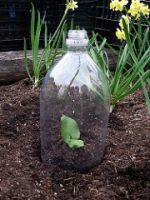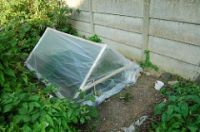How To Make Your Own Cloches & Row Covers
As our gardens make the transition from winter into spring, it can be easy for your hard work to be undone by a late cold snap. One of the best ways to protect plants when cold weather is forecast in the spring is with cloches or row covers. The good news is that it is easy to create your own cloches and row covers using materials that you may already have lying around at home. Here are some DIY cloche and row cover ideas for your garden:
 Simple Bottle Cloches
Simple Bottle Cloches
You can make simple cloches to cover individual seedlings and young plants with the plastic bottles that drinks often come in. Simply cut your plastic bottles in half and place each end over your plants. This will provide them with a little extra protection from the cold, and can also prevent seedlings and tender young plants from being eaten by rodents, rabbits, or other pests looking for food in the early spring. You can use any clear plastic tubs or containers large enough to accommodate your growing plants for this purpose. Using household rubbish in this way also has the added benefit that you will be keeping these items from ending up in landfill. In some cases, these items can still be recycled at the end of their useful second life.
Mini Polytunnels With Plastic Sheeting
A polytunnel can be extremely useful when cold weather is forecast in the spring. A polytunnel helps to mitigate against extremes of temperature and can keep growing plants out of the elements, allowing you to grow food for much more of the year. We don't all have  space for a full-size polytunnel however, so many of us will have to make do with mini polytunnels over our garden beds. You can of course buy these mini tunnels and row covers, but you can also make your own.
space for a full-size polytunnel however, so many of us will have to make do with mini polytunnels over our garden beds. You can of course buy these mini tunnels and row covers, but you can also make your own.
You may even already have access to plastic sheeting which came as packaging for an appliance, for example. It is always a good idea to reuse plastic rather than buying new plastic items whenever possible. Once you have sourced plastic sheeting, you will be able to construct a simple frame to support it over your plants. You can construct a tent-like structure with garden canes or branches, for example, or can use lengths of reclaimed plastic piping or thick garden wire bent into arches to create a tunnel shape.
 Row Covers with Horticultural Fleece or Scrap Fabrics
Row Covers with Horticultural Fleece or Scrap Fabrics
Once you have constructed a simple frame or tunnel shape, you don't have to cover it with plastic. Another option is to simply provide your plants with shelter and a little extra warmth by draping the structure with horticultural fleece, or, alternatively, with pieces of scrap material, such as old blankets or beddings.
The key with DIY cloches and row covers to protect your plants is simply to make the most of whatever you have to hand to provide plants with a little extra protection at this vulnerable time of year.